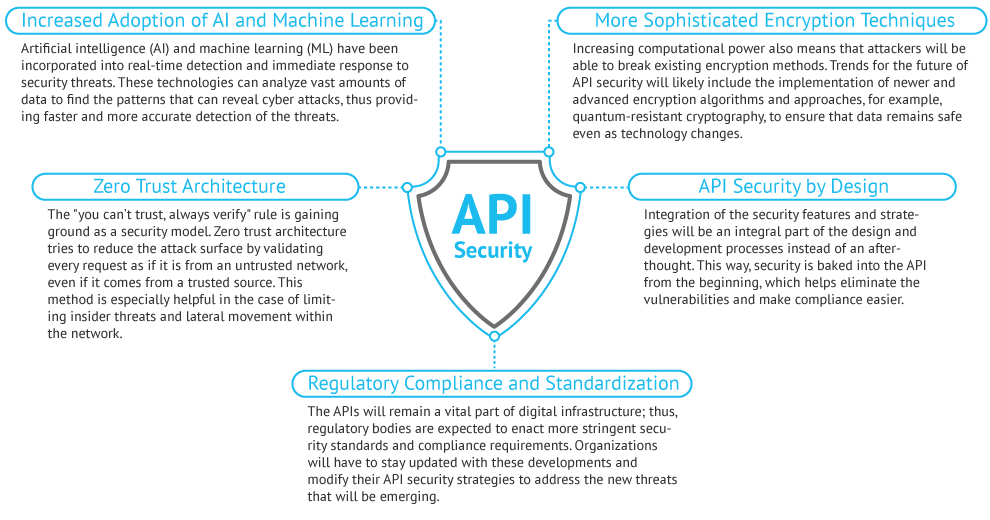Contents
Today, Application Programming Interfaces (APIs) are critical in developing many highly advanced software and services. Simply put, they serve as a connection bridge for the easy and smooth execution of various systems, platforms, and programs.
However, the support of APIs adds extra API security risks. That is why API security must be addressed with the highest priority.
Recent reports highlight that over 80% of web traffic now flows through APIs, making robust API security more critical than ever. With businesses facing increasingly sophisticated attacks, understanding and implementing cutting-edge security measures is no longer optional—it’s a strategic necessity.
In this article, we will discuss what API security is, why it is so significant, and what strategies and API security best practices can be used to keep your API from everyday threats and potential vulnerabilities.
Let’s start with some basics.
What is API security and why is it so important?
API security includes a list of security practices and protocols that protect the APIs from being attacked by hackers and other malicious actors. The API data security protects the data being sent and received through the API and limits any malicious traffic or security vulnerabilities. It also allows that only authorized legitimate users have access to the API.
APIs are one of the main components of software development and modern applications. That is why they have become beacons for potential attacks, as they can grant access to confidential data and systems.
Now, let’s talk about why API security is essential.
In essence, APIs are data gatekeepers in our digital world. An unprotected API can cause data security breaches, economic loss, and reputational damage to the company. So, safeguarding APIs is not just about ensuring data protection but also about securing business continuity, consumer confidence, and data privacy compliance.
Common Attack Types on APIs
To protect APIs adequately, it is vital to understand the patterns of attacks they are usually subjected to.
Here are some prevalent potential threats:
1. Injection Attacks
Like SQL injection, code injection attacks occur when an intruder inserts hostile data in a command or query as part of an attack, resulting in the API executing unintended commands or accessing data without authorization.
Such attacks utilize gaps in the API’s data processing. Crafty attackers and unauthorized users can exploit injection flaws to skip authentication, access confidential information, or even execute administrative operations on the DB backend.
Best practices for API security for these kinds of attacks include validating, sanitizing, and parameterizing user data input by security experts and adopting the principle of least privilege access control on the database.
2. Broken User Authentication and Session Management
APIs that do not set up their authentication mechanisms well can be subjected to an attack where malicious users pretend to be real ones. Hence, this can be achieved by targeting token-based authentication system errors, stealing or guessing session tokens, or taking over user sessions.
Such vulnerabilities in control systems can allow attackers to gain unauthorized access to data and its flow, leading to severe breaches in data privacy and integrity. Securing every layer of user authentication, having a proper authorization policy, setting token expiration and rotation policy, and protecting scope management are the keys to preventing such attacks and any suspicious activity.
3. Insecure Direct Object References (IDOR)
This occurs when an application shows a reference to an internal implementation object, such as a file, directory, or database key, thus helping the attackers exploit these references to access data they are not supposed to have.
IDOR attacks can result in unauthorized viewing and/or data manipulation using predictable object references. The prevention of IDOR attacks calls for the implementation of access controls that verify the user’s authorization to access the requested objects and, alternatively, the use of indirect reference maps that camouflage the direct object references.
4. Man-in-the-Middle (MitM) Attacks
MitM attacks happen when an attacker interrupts communications between two parties (either for eavesdropping or impersonation). Then, the attacker can intercept, manipulate, or steal data. These attacks are especially worrisome for APIs since the data in transit itself often contains sensitive information like personal data, authorization credentials, or financial information.
MitM attacks can be avoided by enforcing TLS-encrypted connections and certifying server authenticity by pinning certificates and informing the users about the secure connections.
5. Cross-Site Scripting Attacks
Regarding API vulnerabilities, Cross-Site Scripting (XSS) attacks are a central and common API security risk, especially for APIs interacting with browsers and processing user input rendered on web pages.
During an XSS attack, the attacker adds malicious scripts to the content sent to a web browser from an API via a browser. A malicious code is then carried out, which may result in session hijacking, stealing user personal information, or manipulating website content to trick users.
Differing from web application vulnerabilities such as conventional XSS attacks, API targeting makes the APIs that deliver content to the web pages the main focus instead. The API security risk is exceptionally high when user-generated content is not correctly processed before it is included in the web response.
XSS attack prevention in the context of APIs requires well-designed input validation and sanitization mechanisms, ensuring any outputs rendered in a web browser are encoded properly to avoid script execution.
Secure Your Data: How to Prevent DDoS Attacks on APIs
Api Security Best Practices for Protecting APIs
1. Authentication and Authorization
Improving authentication and authorization processes is essential in securing APIs. Beyond having basic methods like OAuth 2.0, JSON Web Tokens (JWTs), and API keys, integrating Two-Factor Authentication, Multi-Factor Authentication, or MFA significantly boosts security.
MFA requires users to present multiple verification forms, substantially reducing the possibility of unauthorized access or common threats. This approach includes the blend of what a user knows (as in a password), what a user has (for example, a mobile device or a hardware token), and what a user is (such as using biometrics) for proper authentication of their identity.
The advanced versions of MFA will also include adaptive authentication techniques, where the system regulates and adjusts the required level of authentication, considering the user’s behavior, location, device integrity, and the sensitivity of accessed data. This approach balances security and comfort of use, making it easier for low-risk scenarios and tighter for more dangerous actions and common vulnerabilities.
2. Encryption and Data Integrity
Adopting the TLS 1.3 version, which has better security features than the previous versions, illustrates how encryption technologies are developing. TLS 1.3 decreases the number of round trips during the handshake process, maintaining security and increasing speed. Google uses TLS v1.3 for its APIs to enhance both security and performance.
3. Rate Limiting and Throttling
Rate limiting and throttling are fundamental mechanisms for controlling and managing the API resources to ensure fair and responsible consumption and prevent misuse.
This practice regulates the number of requests a user or a service can issue within a given period, hence lessening the risk of a single customer from grabbing the available resources. This prevents service degradation or denial for other users. Such a robust API security strategy is even more essential for APIs that are publicly available, which are more prone to being misused or intentionally abused.
Rate limiting can be implemented through several strategies, including fixed window limiting, which applies a consistent time window for incoming request allowances, and sliding log limiting, which offers more flexibility by tracking request timestamps. Other methods, such as the token bucket and leaky bucket algorithms, allow for a controlled rate of API requests, accommodating bursts up to a specific limit or smoothing out request rates for more uniform traffic flow.
As a complementary measure, throttling slows down API responses for users exceeding their usage quotas, effectively signaling them to reduce their request rate. Unlike immediate blocking, throttling provides a buffer, encouraging moderation in request behavior without completely cutting off access.
4. Input Validation and Sanitization
Adopting a whitelist approach for input validation, where only explicitly permitted inputs are accepted, can significantly enhance security. This method contrasts with blacklisting, which attempts to identify and block malicious inputs but can often be circumvented. PayPal, for example, employs extensive input validation mechanisms to secure its API endpoints against injection and other API security attacks.
5. Logging and Monitoring
Robust logging and real-time API activity monitoring are the foundation of any good security strategy. This dual approach guarantees the ability not only to trace and understand the normal use routes but also to quickly spot, analyze, and respond to irregular or harmful ones.
The keeping of detailed logs is of the utmost importance for several reasons. Firstly, logs include all transactions and interaction history with the API, which is necessary for post-incident analysis and evaluating the attack scope. They pinpoint the exact point of the attack and attack method, determine the affected data, and assess the effectiveness of the current security measures.
Logs are significant as auditing tools for showing how compliance with regulatory requirements has been followed, and due diligence has been demonstrated in monitoring and protecting sensitive data.
On the other hand, real-time monitoring is an early warning mechanism that finds out security problems as they are happening. Through analyzing traffic patterns, request rates, and access attempts, monitoring systems can notify administrators about anomalous behavior that may signal a security threat, such as repeated failed login attempts, aggregated traffic from unusual locations, or deviating access patterns.
6. Secure Development Practices
Securing software development is achieved through secure coding practices, regular code reviews, and automated API security testing. These are an indispensable part of the software development lifecycle and one of the REST API security best practices. This “shift-left” approach assures that security is part of the early stage design and minimizes the risk of vulnerabilities in the end product.
7. Regular Security Audits and Penetration Testing
Regular security audits and penetration testing are necessary to identify and fix the vulnerabilities. They give security teams a chance to understand the methods the attackers use. They also help to find the weak points and fortify the defenses beforehand.
8. API Gateway Security
Using an API gateway as an additional security layer makes rate limiting, authentication, and threat protection features possible. An API gateway serves as a centralized management point for API traffic, controlling and securing the traffic, thus easing security management and improving the system’s security posture.
9. Compliance with Standards and Regulations
Following the existing security standards and regulations (e.g. GDPR, HIPAA, or PCI DSS) is necessary to guard sensitive data and avoid legal sanctions. Compliance ensures the implementation of Rest API security measures according to the existing benchmarks and the secure and legal management of data.
10. Vendor Security Assessment
Evaluating the security measures of third-party vendors and partners is fundamental for ensuring comprehensive security. This includes checking if the vendors have properly implemented security measures consistent with your security policy to ensure that there would be no vulnerability adoption through third-party integrations.
Optimizing Your API Strategy: Best Practices for API Management in 2024
Future Trends in API Security
As digital technologies keep evolving, web API security does too. Keeping up with these trends is what organizations must do to secure their data and systems in the best way possible.
Here are some key future trends in API security:
Increased Adoption of AI and Machine Learning
Artificial intelligence (AI) and machine learning (ML) have been incorporated into real-time detection and immediate response to security threats. These technologies can analyze vast amounts of data to find the patterns that can reveal cyber attacks, thus providing faster and more accurate detection of the threats.
Zero Trust Architecture
The “you can’t trust, always verify” rule is gaining ground as a security model. Zero trust architecture tries to reduce the attack surface by validating every request as if it is from an untrusted network, even if it comes from a trusted source. This method is especially helpful in the case of limiting insider threats and lateral movement within the network.
More Sophisticated Encryption Techniques
Increasing computational power also means that attackers will be able to break existing encryption methods. Trends for the future of API security will likely include the implementation of newer and advanced encryption algorithms and approaches, for example, quantum-resistant cryptography, to ensure that data remains safe even as technology changes.
API Security by Design
Integration of the security features and strategies will be an integral part of the design and development processes instead of an afterthought. This way, security is baked into the API from the beginning, which helps eliminate the vulnerabilities and make compliance easier.
Regulatory Compliance and Standardization
The APIs will remain a vital part of digital infrastructure; thus, regulatory bodies are expected to enact more stringent security standards and compliance requirements. Organizations will have to stay updated with these developments and modify their API security strategies to address the new threats that will be emerging.
Emerging Trends in API Security
API security is evolving rapidly with new technologies and threats. Zero Trust Architecture (ZTA) is gaining traction, requiring continuous verification of users and devices. AI and ML are transforming threat detection by identifying vulnerabilities in real-time. Meanwhile, API Observability tools provide deeper insights to address risks swiftly, enhancing security and performance. These innovations are shaping a safer digital future for APIs.
Conclusion
API security is an integral part of digital security strategies in the modern era. Along with the growth of APIs, their security against different cyber threats has become the main focus for many companies.
Through adopting our API security best practices, organizations will be better armed to strengthen their API security stance, safeguard confidential information, and retain the confidence of their consumers and partners.
Moreover, it is vital to follow the trends in API security’s future and adapt to new technologies and threats to protect against cyber attacks. Organizations can then successfully maneuver the digital complexities with the help of a proactive and comprehensive approach to Restful API security.
However, knowledge, vigilance, and adaptability are indispensable in the API securing journey. For further insights and expertise in API development and security, consider exploring resources and services specializing in this critical field.












